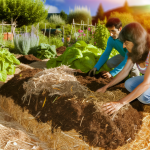Have you ever wondered if you can grow a thriving garden in a small space? The answer is a resounding yes! With the right approach, even limited areas like patios or balconies can become a haven for fresh produce. One of the best plants to try? Squash.
Many gardeners ask, “Do squash grow well in containers?” The truth is, with proper care, they can flourish. Container gardening offers unique advantages, like controlled soil quality and reduced risk of soil-borne diseases. Plus, it’s a fantastic way to maximize space without sacrificing yield.
In this guide, I’ll walk you through everything you need to know about growing squash in containers. From selecting the right setup to harvesting your bounty, you’ll discover how easy and rewarding it can be. Let’s transform your space into a productive garden!
Key Takeaways
- Squash can thrive in containers with proper care and setup.
- Container gardening is ideal for small spaces like patios or balconies.
- Controlled soil quality reduces the risk of soil-borne diseases.
- Proper drainage and container size are crucial for healthy growth.
- Growing squash in containers saves space while providing fresh produce.
Getting Started with Growing Squash in Containers
Limited space doesn’t mean you can’t enjoy fresh, homegrown produce. With the right approach, even a small balcony or patio can become a thriving garden. One of the best plants to try is squash. It’s versatile, rewarding, and surprisingly adaptable to confined areas.
Why Container Gardening for Squash?
Growing in pots offers unique advantages. You can control the soil quality, ensuring it’s rich and well-draining. This reduces the risk of soil-borne diseases. Plus, it’s easier to manage moisture levels, which is crucial for healthy growth.
Starting with seeds or transplants? I recommend seeds for a more hands-on experience. Plant them about two weeks after the last frost. Keep the soil warm, and you’ll see sprouts in about a week. From there, consistent care will lead to a bountiful harvest.
Overview of Squash Varieties for Limited Spaces
Not all types are created equal. For small areas, compact bush varieties are ideal. They take up less room but still produce plenty of fruit. Summer varieties like zucchini are quick to mature, while winter types like butternut offer long storage.
Choosing the right one depends on your goals. Want fresh produce all season? Go for summer squash. Prefer something you can store for months? Winter varieties are your best bet. Either way, you’ll enjoy the fruits of your labor.
Choosing the Perfect Container for Your Squash
Finding the right pot is the first step to growing healthy plants. The size, depth, and material of your container directly impact your plant’s success. Let’s dive into the essentials to help you make the best choice.
Container Size, Depth, and Drainage Requirements
The pot size should be at least 24 inches in diameter and 12 inches deep. This provides enough space for roots to spread and grow. A larger pot also helps maintain consistent moisture levels.
Proper drainage holes are essential. Without them, water can pool at the bottom, leading to root rot. Ensure your pot has enough holes to allow excess water to escape.
Can you use a 5-gallon bucket? Yes, but make sure it’s deep enough and has adequate drainage. A bucket can work well for compact varieties, but larger plants may need more room.
Selecting Materials and Potting Options
Different materials affect soil temperature and moisture retention. Plastic pots are lightweight and retain moisture well, while terra cotta is breathable but dries out faster. Choose based on your climate and watering habits.
A high-quality potting mix is crucial. Look for a blend that includes perlite or vermiculite for drainage and organic matter for nutrients. The right soil mix promotes healthy roots and robust growth.
Remember, the quality of your pot and soil directly influences your plant’s health. Invest in the best you can afford to ensure a bountiful harvest.
Optimizing Soil, Watering, and Fertilization
The secret to a bountiful harvest lies in the foundation of your garden—soil, water, and nutrients. Getting these elements right ensures your plants thrive and produce flavorful, healthy fruit. Let’s break down the essentials for success.
Crafting the Ideal Potting Mix
Start with a high-quality potting mix. Combine it with compost and organic matter like peat moss. This blend ensures proper drainage and nutrient availability. Soil composition directly affects the flavor and texture of your produce.
For best results, aim for a soil pH between 5.8 and 6.8. This range supports optimal nutrient absorption. If you’re unsure, test your soil with a simple kit available at most garden centers.
Watering Frequency and Nutrient Needs
Consistent moisture is crucial. Check the top two inches of soil; if it’s dry, it’s time to water. Aim for 1 to 1½ inches of water per week, ensuring it penetrates 6 to 8 inches deep.
Fertilize regularly to keep your plants healthy. Use a balanced fertilizer like Miracle-Gro every 2-3 weeks. Timing is key—apply nutrients during active growth phases for the best results.
| Factor | Optimal Range |
|---|---|
| Soil pH | 5.8 – 6.8 |
| Soil Temperature | 65 – 80°F |
| Watering Depth | 6 – 8 inches |
By focusing on these fundamentals, you’ll create an environment where your plants can flourish. Remember, healthy soil and proper watering are the cornerstones of a successful garden.
Container Squash: Essential Tips and Setup
Want to grow flavorful produce in a small space? Here’s how to make it happen. With the right setup, you can enjoy a bountiful harvest of delicious squash, even in tight areas like patios or balconies. Let’s dive into the essentials for success.
Best Tasting and Container-Friendly Squash Varieties
Choosing the right variety is key to maximizing flavor and performance. Compact bush types like Black Magic Zucchini or Bush Acorn are ideal for limited spaces. These plants produce plenty of fruit without taking up too much room.
For summer harvests, zucchini is a top pick. It’s best picked when about 6 inches long for optimal flavor. Winter varieties like butternut are perfect for storage, offering long-lasting freshness. Remember, the right choice depends on your goals—fresh eating or long-term storage.

Using Fertilizers, Including Miracle-Gro, Effectively
Fertilization is crucial for healthy growth and a bountiful harvest. I recommend using a balanced fertilizer like Miracle-Gro every 2-3 weeks. This ensures your plants get the nutrients they need during active growth phases.
Apply fertilizer evenly around the base of the plant, avoiding direct contact with the stems.
“Proper fertilization not only boosts yield but also enhances the flavor and texture of your produce.”
For best results, combine fertilization with consistent watering and quality soil.
By selecting the right varieties and using fertilizers effectively, you’ll enjoy a thriving garden full of flavorful produce. Timely harvest—when the fruit reaches the right size—ensures maximum taste and nutritional value. Start today and transform your space into a productive oasis!
Managing Sunlight, Temperature, and Pests
Growing healthy plants requires more than just water and soil—it’s about managing sunlight, temperature, and pests effectively. These factors play a crucial role in ensuring your plants thrive and produce a bountiful harvest. Let’s explore how to optimize these elements for success.
Understanding Sunlight and Climate Requirements
Squash plants need at least six hours of direct sunlight daily to grow well. Place your pots in a spot where they can soak up the sun without obstruction. Too much heat, however, can stress the plant. Monitor the temperature and provide shade during the hottest part of the day if needed.
Proper air circulation is also essential. It helps prevent fungal issues like powdery mildew, which thrives in stagnant air. Space your plants adequately to allow airflow and reduce the risk of disease.
Strategies for Pest Prevention and Disease Control
Pests like squash bugs can wreak havoc on your plants. Regularly inspect the leaves and stems for signs of infestation. If you spot any, act quickly to remove them. Organic sprays, such as neem oil, are effective and safe for your plants.
Fungal diseases, particularly powdery mildew, are common in humid conditions. To prevent this, avoid overhead watering and ensure the soil drains well. If you notice white patches on the leaves, treat them with a baking soda solution or a fungicide.
“Healthy plants start with proper care. By managing sunlight, temperature, and pests, you can enjoy a thriving garden full of fresh produce.”
Understanding your plant’s needs and taking proactive steps will keep them healthy and productive. With the right balance of sunlight, temperature control, and pest management, your garden will flourish.
Companion Planting and Crop Arrangement for Success
Companion planting can transform your garden into a thriving ecosystem. By pairing the right plants, you can boost growth, reduce pests, and improve overall health. This method is especially useful for maximizing space and ensuring your garden bed remains productive.
Pairing Squash with Zucchini, Cucumbers, and Tomatoes
Certain plants thrive when grown together. For example, zucchini and cucumbers are excellent companions for squash. These vines share similar needs for sunlight and water, making them ideal neighbors. Tomatoes also pair well, as they deter pests that might harm squash.
Marigolds are another great addition. They attract beneficial insects while repelling harmful ones. This creates a balanced environment where your plants can flourish. Choosing the right place for each plant ensures they get the resources they need without competing.
What Not to Plant Next to Squash, Peppers, and Cucumbers
Not all plants make good neighbors. Avoid planting peppers near squash, as they can compete for nutrients and increase the risk of rot. Irish potatoes are another poor choice, as they deplete the soil of essential resources.
Vining crops like pumpkins should also be kept separate. They can overcrowd the garden bed, limiting airflow and sunlight. Proper spacing and thoughtful arrangement are key to preventing these issues.
“Companion planting isn’t just about growth—it’s about creating a harmonious garden where each plant supports the others.”
By selecting compatible plants and avoiding harmful pairings, you can ensure your squash grown remains healthy and productive. Start planning your garden today and enjoy the benefits of a well-arranged space!
Advanced Techniques: Training, Trellising, and Pruning
Vertical gardening is a game-changer for maximizing space and improving plant health. By training vines to climb, you can significantly boost productivity and reduce common issues like powdery mildew. Let’s explore how to master these advanced techniques for healthier, more abundant harvests.
How to Train Zucchini and Squash Vines to Climb
Start training your vines early to encourage vertical growth. Gently guide the stems toward a trellis or stake as they grow. Use soft ties to secure the vines without damaging them. This method not only saves space but also increases sun exposure, leading to faster ripening and better fruit quality.
Pruning is another key step. Remove excess foliage to improve airflow and reduce the risk of mildew. Focus on redirecting the plant’s energy into producing fruit rather than unnecessary leaves. Regular pruning also makes it easier to spot and address pests early.
Effective Use of Stakes and Trellises in Container Gardening
Stakes and trellises are essential for supporting vertical growth. Choose sturdy materials like bamboo or metal to ensure they can handle the weight of mature plants. Position the trellis securely in the pot to prevent tipping as the vines grow heavier.
Proper spacing is crucial. Keep plants at least 2 feet apart to allow adequate airflow and reduce the risk of powdery mildew. This setup also makes it easier to water and fertilize each plant effectively.
“Vertical gardening not only maximizes space but also enhances fruit quality and reduces pest damage.”
By combining these techniques, you’ll create a thriving garden that produces healthy, flavorful fruit. Start today and enjoy the benefits of growing smarter, not harder!
Conclusion
Growing plants in confined spaces can be incredibly rewarding with the right techniques. From selecting the perfect pot to managing sunlight and pests, each step plays a vital role in ensuring a healthy harvest. Remember, a drainage hole is essential to prevent water retention and root rot, keeping your plants thriving.
Be mindful of frost when planning your growing season. Protecting your plants during cooler months ensures they stay healthy and productive. By following these detailed steps, you’ll create a high-yield garden that maximizes space and flavor.
Experiment with advanced techniques like trellising and companion planting to enhance your results. Use this guide as a reliable resource for future gardening ventures. Start today and enjoy the satisfaction of growing your own fresh produce!




